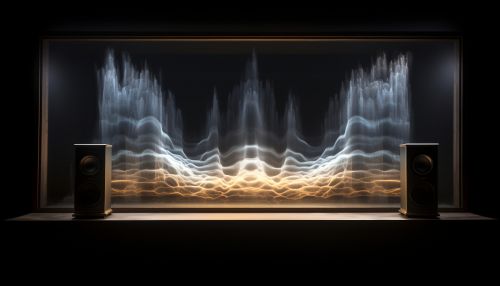Acoustics
Introduction
Acoustics is a branch of physics that deals with the study of all mechanical waves in gases, liquids, and solids including topics such as vibration, sound, ultrasound and infrasound. A scientist who works in the field of acoustics is an acoustician while someone working in the field of acoustics technology may be called an acoustical engineer. The application of acoustics is present in almost all aspects of modern society with the most obvious being the audio and noise control industries.


History of Acoustics
The study of acoustics dates back to ancient times. In the 6th Century BC, the ancient Greek philosopher Pythagoras experimented with strings of different lengths, and discovered that the ratios of the lengths produced harmonious sounds when plucked, a discovery fundamental to the musical concept of harmony. In the 6th century AD, the Indian mathematician-astronomer Aryabhata wrote the Aryabhatiya, which contains a treatise on music and acoustics, discussing echo (Pratiśruti), reverberation (Prati-praśruti), and resonance (Saṃdāna), the first known description of the phenomenon.
The Physics of Acoustics
Acoustics is derived from the Greek word ακουστικός (akoustikos), meaning "of or for hearing, ready to hear". Acoustics is the science that deals with the production, control, transmission, reception, and effects of sound. The study of acoustics revolves around the generation, propagation and reception of mechanical waves and vibrations.
The Wave Equation
The wave equation is a differential equation that describes how waves propagate: the equation is linear, which means that the superposition of two solutions is also a solution. The wave equation in acoustics is derived from the linear approximation to the fluid dynamics equations.
Sound Fields
The sound field is the region in a medium or space in which sound waves are present. The field can be described by a vector function of position and time, which represents the displacement of the medium particles in the field.
Acoustic Wave
An acoustic wave propagates through a medium by means of adiabatic compression and decompression. The properties of an acoustic wave are frequency, wavelength, wave number, amplitude, intensity, speed, and direction.
Acoustic Phenomena
There are several distinct phenomena which can be studied by acoustics.
Resonance
Resonance occurs when an object vibrates at its natural frequency, the frequency that will produce the maximum amplitude. Resonance phenomena occur with all types of vibrations or waves: there is mechanical resonance, acoustic resonance, electromagnetic resonance, nuclear magnetic resonance (NMR), electron spin resonance (ESR) and resonance of quantum wave functions.
Beats
Beats are the periodic and repeating fluctuations heard in the intensity of a sound when two sound waves of very similar frequencies interfere with one another.
Acoustic Dispersion
Acoustic dispersion is the phenomenon of a sound wave separating into its component frequencies as it travels through a medium. The "rainbow" is a natural example of dispersion.
Doppler Effect
The Doppler Effect is the change in frequency or wavelength of a wave for an observer moving relative to the source of the waves.
Acoustic Measurement and Noise Control
Acoustic measurement is a sub-discipline of acoustics dealing with the measurement of sound and vibration. Noise control is a set of strategies to reduce noise pollution by reducing noise at its source, by inhibiting sound propagation using noise barriers or similar, or by the use of ear protection (control at the receiver).
